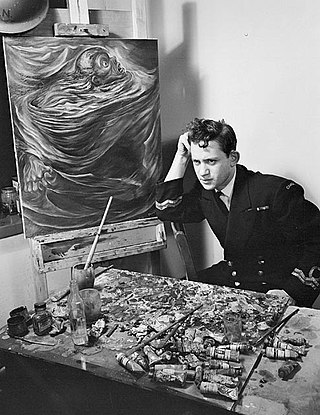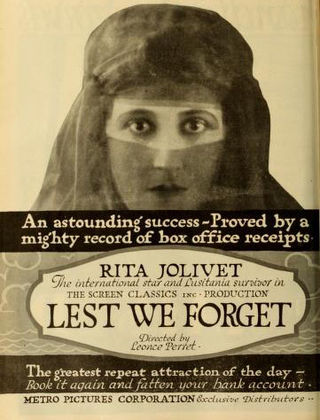Related Research Articles

A newsreel is a form of short documentary film, containing news stories and items of topical interest, that was prevalent between the 1910s and the mid 1970s. Typically presented in a cinema, newsreels were a source of current affairs, information, and entertainment for millions of moviegoers. Newsreels were typically exhibited preceding a feature film, but there were also dedicated newsreel theaters in many major cities in the 1930s and ’40s, and some large city cinemas also included a smaller theaterette where newsreels were screened continuously throughout the day.

Walter Seymour Allward was a Canadian monumental sculptor best known for the Canadian National Vimy Memorial. Featuring expressive classical figures within modern compositions, Allward's monuments evoke themes of memory, sacrifice, and redemption. He has been widely praised for his "original sense of spatial composition, his mastery of the classical form and his brilliant craftsmanship".

Cinema in Canada dates back to the earliest known display of film in Saint-Laurent, Quebec, in 1896. The film industry in Canada has been dominated by the United States, which has utilized Canada as a shooting location and to bypass British film quota laws, throughout its history. Canadian filmmakers, English and French, have been active in the development of cinema in the United States.

Arthur Lismer, LL.D. was an English-Canadian painter, member of the Group of Seven and educator. He is known primarily as a landscape painter and for his paintings of ships in dazzle camouflage.

Alexander Young Jackson LL. D. was a Canadian painter and a founding member of the Group of Seven. Jackson made a significant contribution to the development of art in Canada, and was instrumental in bringing together the artists of Montreal and Toronto. In addition to his work with the Group of Seven, his long career included serving as a war artist during World War I (1917–19) and teaching at the Banff School of Fine Arts, from 1943 to 1949. In his later years he was artist-in-residence at the McMichael Canadian Art Collection in Kleinburg, Ontario.

Frederick Horsman Varley was a member of the Canadian Group of Seven.

The March of Time is an American newsreel series sponsored by Time Inc. and shown in movie theaters from 1935 to 1951. It was based on a radio news series broadcast from 1931 to 1945 that was produced by advertising agency Batten, Barton, Durstine & Osborn (BBDO). The "voice" of both series was Westbrook Van Voorhis. Produced and written by Louis de Rochemont and his brother Richard de Rochemont, The March of Time was recognized with an Academy Honorary Award in 1937.
Lest We Forget may refer to:

Jack Nichols (1921–2009) was a Canadian artist from Montreal, Quebec. He was a painter and printmaker whose main interest in his art was people in the metropolitan scene. He was called by critics "a chronicler of the human condition" and compassionate in his depictions.
Kazuo Nakamura was a Japanese-Canadian painter and sculptor and a founding member of the Toronto-based Painters Eleven group in the 1950s. Among the first major Japanese Canadian artists to emerge in the twentieth century, Nakamura created innovative landscape paintings and abstract compositions inspired by nature, mathematics, and science. His painting is orderly and restrained in contrast to other members of Painters Eleven. His idealism about science echoed the beliefs of Lawren Harris and Jock Macdonald.

Pegi Nicol MacLeod,, was a Canadian painter whose modernist self-portraits, figure studies, paintings of children, still lifes and landscapes are characterized by a fluidity of form and vibrant colour. Born Margaret Kathleen Nichol, she was a teacher, war artist and arts activist. In 1936 she became a member of the Canadian Society of Painters in Water Colour and one year later she joined the Canadian Group of Painters.
Associated Screen News of Canada (ASN) was a Montreal-based film production company which, from the mid-1920s to the 1950s, was the largest private film production company in Canada.

David Collier is a Canadian alternative cartoonist best known for his fact-based "comic strip essays."

The Wartime Information Board was a Canadian government agency established on 9 September 1942, succeeding the Bureau of Public Information, to coordinate the existing public information service of the government, supervise the release from government sources of Canadian war news and information, and facilitate distribution of Canadian war information both internally and externally.
Canadian official war artists create an artistic rendering of war through the media of visual, digital installations, film, poetry, choreography, music, etc., by showing its impact as men and women are shown waiting, preparing, fighting, suffering, celebrating. These traditionally were a select group of artists who were employed on contract, or commissioned to produce specific works during the First World War, the Second World War and select military actions in the post-war period. The four Canadian official war art programs are: the First World War Canadian War Memorials Fund (CWMF), the Second World War Canadian War Records (CWR), the Cold War Canadian Armed Forces Civilian Artists Program (CAFCAP), and the current Canadian Forces Artists Program (CFAP).

Marion Long was an artist, elected to the Royal Canadian Academy in 1922. She was often commissioned to paint portraits, sometimes of military figures. She is known for her urban scenes.
The Canadian Government Motion Picture Bureau, founded as the Exhibits and Publicity Bureau, was the film production agency of the Government of Canada administered by the Department of Trade and Commerce, and intended to promote trade and industry. Created in 1918, it was the first government film production organization in the world.

Lest We Forget is a 1918 American World War I espionage drama silent film directed by Leonce Perret and produced by and starring Rita Jolivet. The film was released by the Metro Pictures company. While the picture is essentially a spy film, it may also be considered a propaganda film popular during World War I.

Policing the Plains is a 1927 Canadian silent historical docudrama film directed by Arthur D. Kean and based on the book of the same name by R.G. MacBeth. It depicted the first fifty years of the Royal North-West Mounted Police.
Leon C. Shelly (1906–1987) was a Canadian producer of industrial and sponsored films, active in Vancouver (1936–1945) and in Toronto (1945–1969).
References
- ↑ Reid, Escott (May 4, 1935). "Lest We Forget". Saturday Night. 50: 12. ISBN 9780802029881.
- ↑ Cook, Tim (2005). "Canada's Great War on Film: Lest We Forget (1935)". Canadian Military History. 4 (3).
- ↑ James, C. Rodney (1977). Film As a National Art: NFB of Canada and the Film Board Idea. New York: Arno Press. pp. 39, 41. ISBN 0-405-09891-X.
- ↑ Morris, Peter (1984). The Film Companion . Toronto: Irwin Publishing. p. 180. ISBN 0-7725-1505-0.
- 1 2 3 Brandon, Laura (2021). War Art in Canada: A Critical History. Toronto: Art Canada Institute. ISBN 978-1-4871-0271-5.
- ↑ Backhouse, Charles F. (1974). The Canadian Government Motion Picture Bureau 1917-1941 . Ottawa: Canadian Film Institute. pp. 122–123.